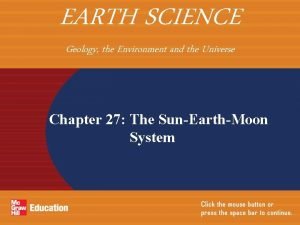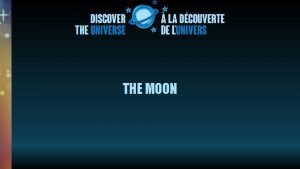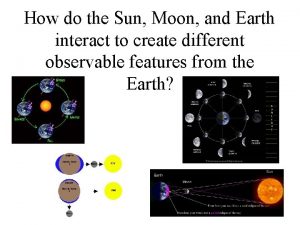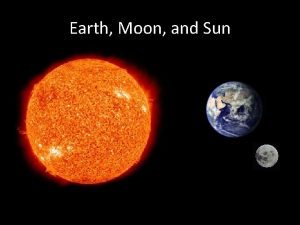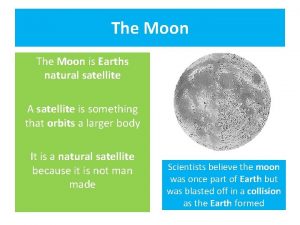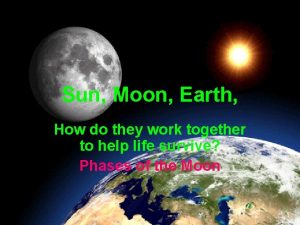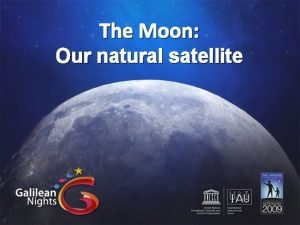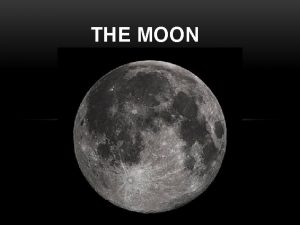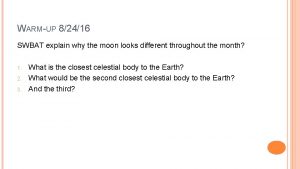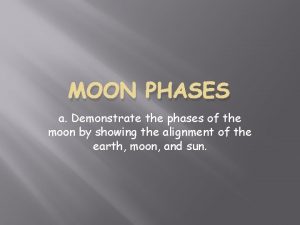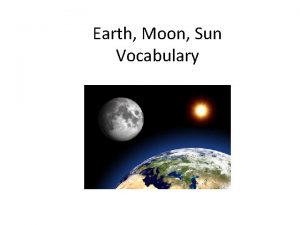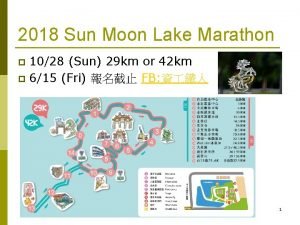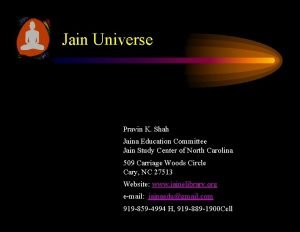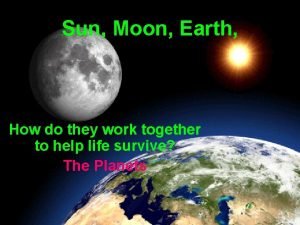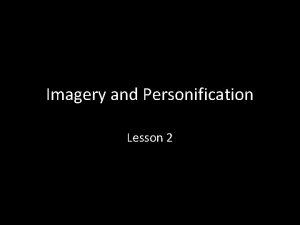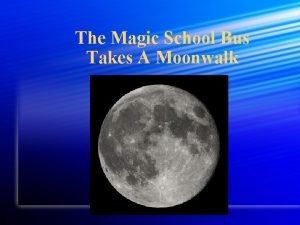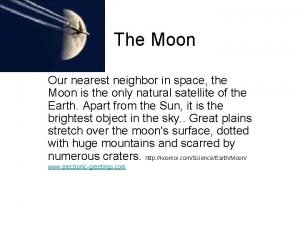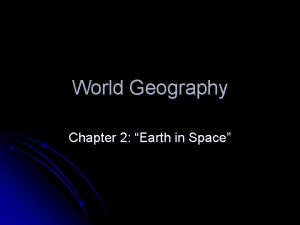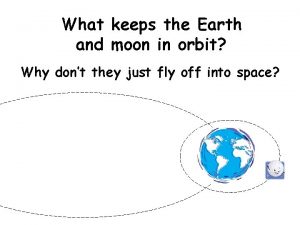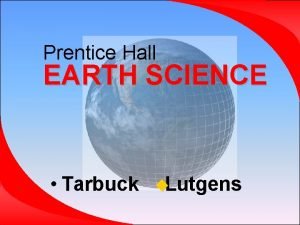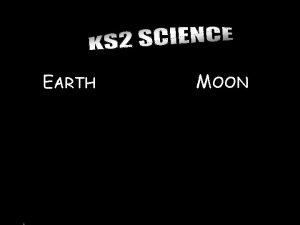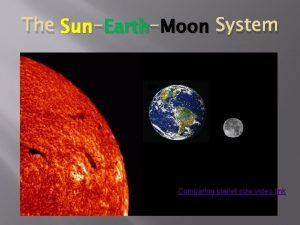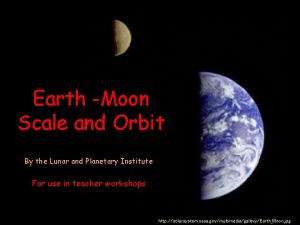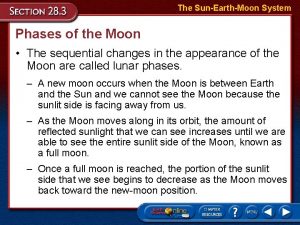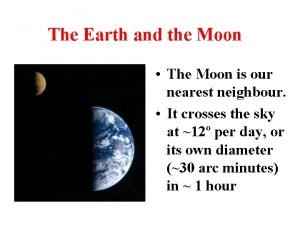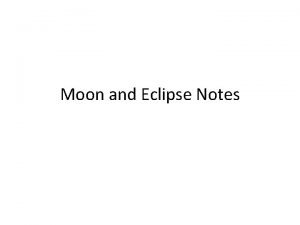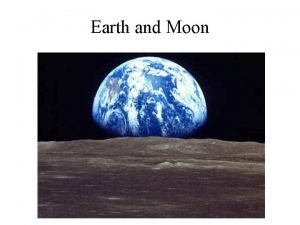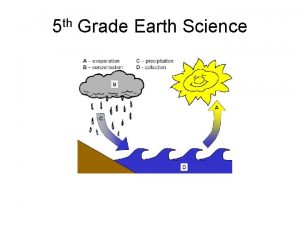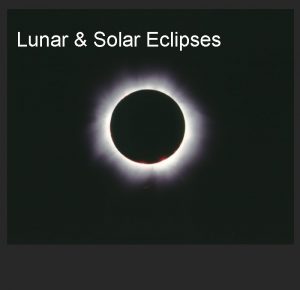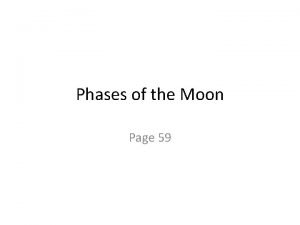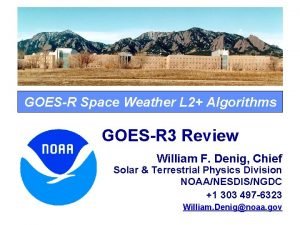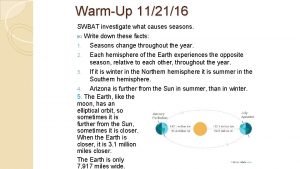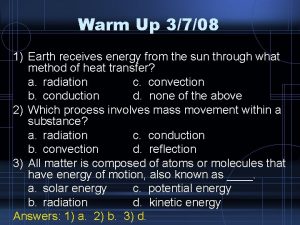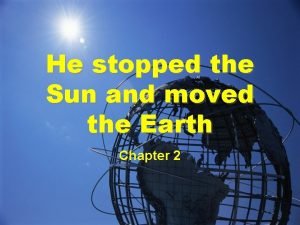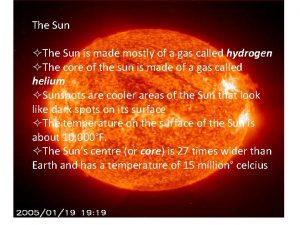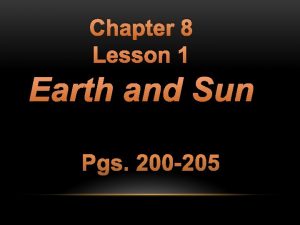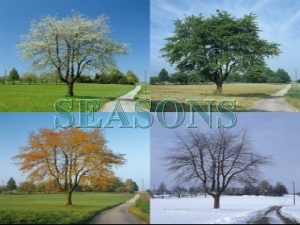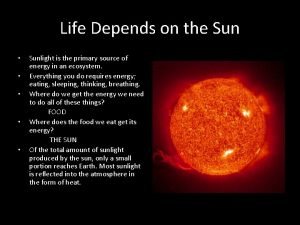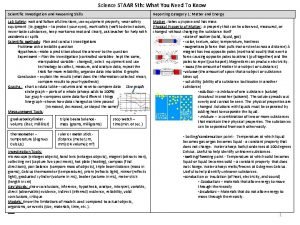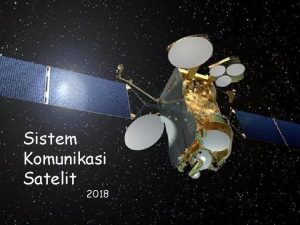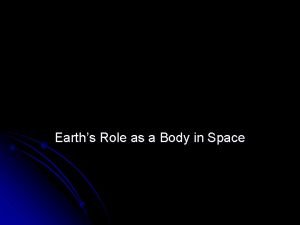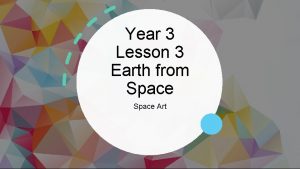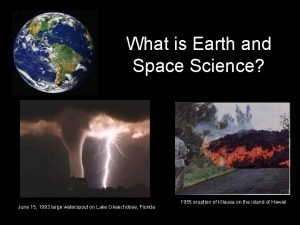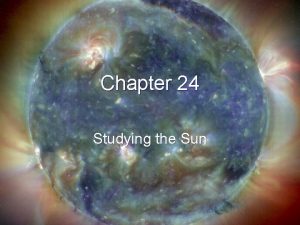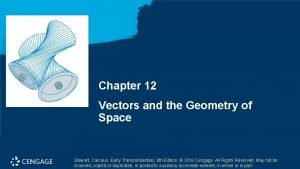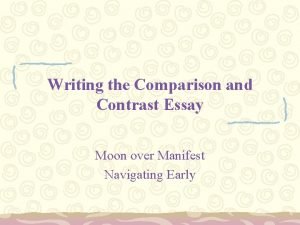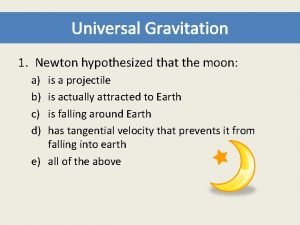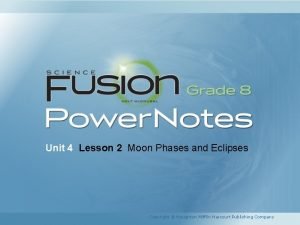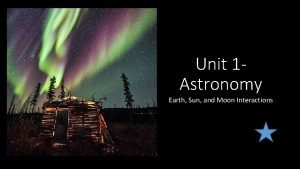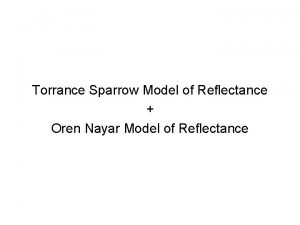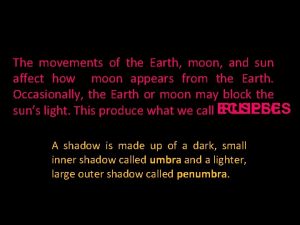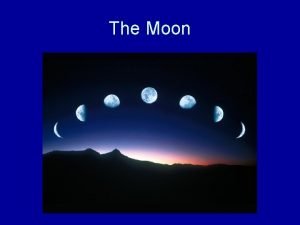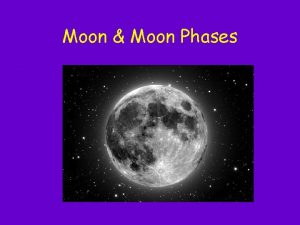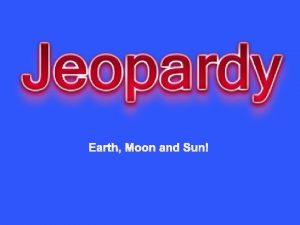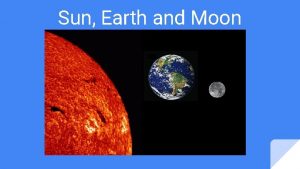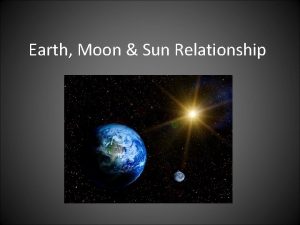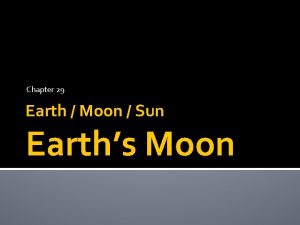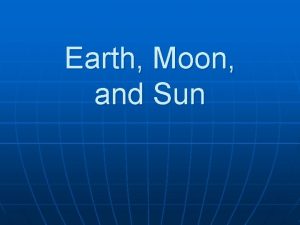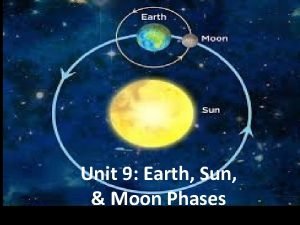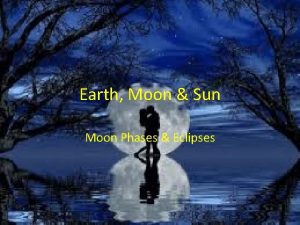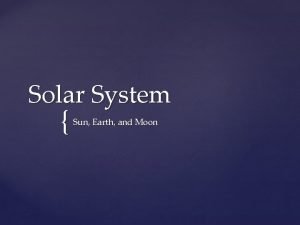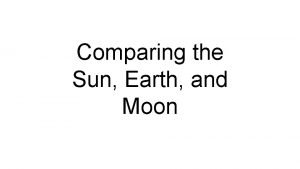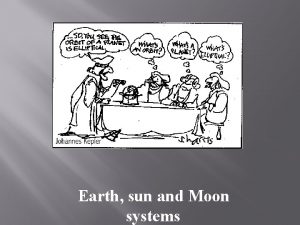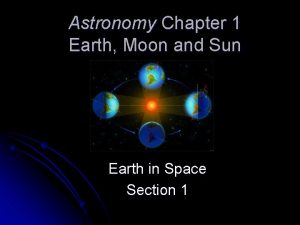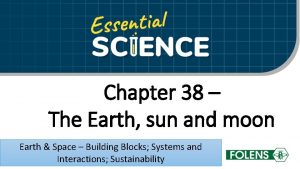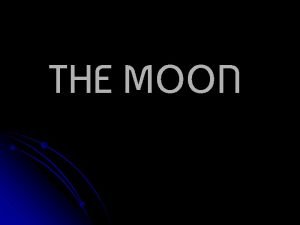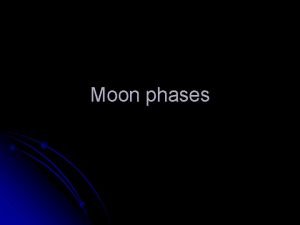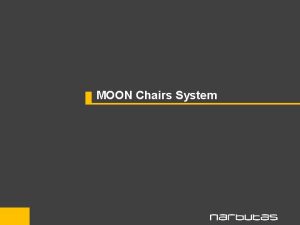Earth Moon Sun Chapter 7 Earth in Space











































































- Slides: 75

Earth, Moon, Sun Chapter 7

Earth in Space Chapter 7, Section 1

Earth’s size and shape • Earth is a sphere – How do we know? • No matter where you are on Earth, gravity causes all objects to fall toward the center of the Earth • If you are on a ship approaching land, you see the tops of the tallest buildings first and the ground level last.


World

Other fun Earth facts: • • • Diameter: Equator=12, 756 km, Pole=12, 714 km Circumference: Eq=40, 075 km, Pole=40, 008 km Mass: 598, 000, 000, 000 kg Avg. Distance to Sun: 149, 600, 000 Km Avg. Distance to Moon: 384, 400 Km Period of rotation: 23 hr, 56 min, 4 sec (sidereal day relative to the distant stars) • Rotation: 24 hr 4 sec (solar day relative to sun) • Period of revolution: 365 ¼ days

Earth’s magnetic field • The outer core of the Earth spins at a different speed than the outer layers; this causes a magnetic field with North and South magnetic poles • The magnetic poles are not static and move periodically • The magnetic poles deflect the solar wind, a stream of harmful electromagnetic particles ejected by the Sun.

The magnetic poles

Earth as a magnet

Magnetic poles deflecting the solar wind

Earth’s magnetic field • Some of these E. M. particles are pulled into the Earth’s magnetic poles • When this occurs, their energy can cause the particles in the atmosphere to glow • This phenomenon is called the Aurora Borealis (or Aurora Australis in the Southern Hemisphere)

Aurora






Space Weather site • http: //spaceweather. com/

Earth orbits the Sun • Just like the orbits of all of the planets, moons, and comets, the Earth’s orbit is an ellipse. • What is another word for ellipse? • Ellipse = oval • Of the three other terrestrial (rocky surface) planets, Venus’s atmosphere is the most like Earth, but conditions on Mars are most like Earth • Venus is considered to be Earth’s twin due to its size!


Arizona Meteor Crater

7. 1 Earth Analysis: Date____ Name_______ Hr__ Copy and answer in complete sentences: 1. Evidence indicates that Mars once had liquid water on its surface. What evidence could it be? 2. List at least 2 reasons Mars has none today? 3. Earth’s circumference at the equator is about 40, 075 km (24, 901 miles). If it spins once each day, what is the spinning speed in miles/hour? Round your answer to 2 decimal places.

Time and Seasons Chapter 7, Section 2

Measuring time on Earth • The Earth makes one rotation in apx. 24 hours. • This spinning causes the Sun to appear to move across the sky from east to west. • If the Earth spins 360° every 24 hours then it spins 15° every hour (hence time zones). • Time zones are modified to fit cities, regions, or even countries.

Time Zones

International Date Line • The International Date Line is located at 180° longitude (in the middle of the Pacific) • The Earth makes one revolution around the Sun every 365. 25 days • The Earth’s orbit around the Sun is in an ellipse (an elongated circular path)

Why do seasons change? • The seasons are not caused by how close we are to the Sun!!!! • The seasons are caused by the axis, or tilt, of the Earth on its axis – The tilt of the axis is 23. 5° (Tropics) • During our summer, the Northern Hemisphere gets more direct sunlight and more hours of it than the Southern Hemisphere does. • During our winter, the Northern Hemisphere gets less direct sunlight and less hours of it than the Southern Hemisphere does.

Tropics

Sun not in the center!

Intensity during the year

The Sun’s intensity varies on your latitude

Ultraviolet Radiation=UV • Exposure to ultraviolet (UV) radiation is a major risk factor for most skin cancers. Sunlight is the main source of UV rays. Tanning lamps and beds are also sources of UV rays. People who get a lot of UV exposure from these sources are at greater risk for skin cancer. • Even though UV rays make up only a very small portion of the sun’s rays, they are the main cause of the sun’s damaging effects on the skin.

How does UV hurt us? • UV rays damage the DNA of skin cells. Skin cancers start when this damage affects the DNA of genes that control skin cell growth. • • There are 3 main types of UV rays: UVA UVB UVC

UV rays are NOT safe! • UVA rays age skin cells and can damage DNA. They cause wrinkles, but they are also cause some skin cancers. Tanning beds give off alot of UVA, which increases skin cancer risk. • UVB rays have more energy than UVA rays. They damage DNA directly and are the main cause of sunburns. They also cause most skin cancers. • UVC rays have the most energy but are not in sunlight and do not usually cause skin cancer.

UV ray strength Strength of UV rays depends on factors such as: • Time of day: UV strongest from 10 am to 4 pm. • Season: UV stronger during spring and summer. • Distance from equator: UV exposure goes down as you get further from the equator. • Altitude: More UV rays at higher elevations. • Clouds: Some clouds block UVwhile some clouds reflect UV and can increase UV exposure. But UV can get through, even on a cloudy day.

UV Exposure • Reflection off surfaces: UV rays can bounce off surfaces like water, sand, snow, pavement, or grass, leading to an increase in UV exposure. • Wear SUNSCREEN!!! • Skin cancer may take years to show up. • The FDA says that Melanoma, the deadliest form of skin cancer, is linked to getting severe sunburns, especially at a young age.

Mole vs Cancer • All skin growths should be monitored. • Especially look for changing colors or non-round shapes. • If unsure see a doctor. • See picture…

Length of Day

• At only two times during the year, all places on Earth have 12 hours of daylight and 12 hours of darkness. – They are called the equinox and occur on apx. March 21 st and September 22 nd. • On apx. June 21 st, the summer solstice occurs. It is the day with the most hours of sunlight in the Northern Hemisphere and the day with the least hours of sunlight in the Southern Hemisphere. – On this day, the sun can be seen directly overhead at the Tropic of Cancer.

• The opposite of the summer solstice is the winter solstice. It is the day with the most hours of sunlight in the Southern Hemisphere and the day with the least hours of sunlight in the Northern Hemisphere. – On this day, the sun can be seen directly overhead at the Tropic of Capricorn.

7. 2 Time-Season Analysis Name______ Hr_ Date__ Copy and answer in complete sentences. 1. Why is each timezone 15 degrees wide on Earth? 2. 4: 15 in Detroit is what time in Los Angeles? 3. What is the difference in rotation and revolution? 4. Why does Earth’s surface get warmer in summer? 5. Earth travels 360 degrees in its orbit taking about 365. 25 days. How many degrees is that each day? Round your answer to 2 decimal places.

What are these?

Earth’s Moon Chapter 7, Section 3

Movement of the Moon • The Moon revolves around the Earth every 27. 3 days. • The Moon rotates (27. 3 days) at the same speed that it revolves! So, the same side of the Moon always faces the Earth. • How Does the Moon affect gravity? • All objects that have mass have gravity. The Moon’s gravity also pulls on the Earth and all objects on Earth, causing ocean tides. The sun’s gravity also pulls on the tides too!

Tide

Tide and Erosion

Moonlight • The Moon shines because it reflects sunlight off of its surface • Just like half of the Earth experiences day while the other half is night, so does the Moon. • Moon phases are the changing appearances of the Moon as seen from Earth. The phase you see depends on the relative positions of the Sun, Earth, and Moon.


Random Moon Phase Facts • It takes the moon 29. 5 days to complete the phases. • Two full moons in one calendar month is called a blue moon. • Technically, each moon phase only lasts an instant…. . but to our eyes, it looks the same for 3 ½ days! • Waxing phase: right side is reflecting light and continues to reflect more each night. • Waning phase: left side is reflecting light and reflects less light each night.





Eclipses • There are two types of eclipses: – Solar eclipse – when the Moon casts a shadow onto the Earth – Lunar eclipse – when the Earth casts a shadow onto the Moon • Eclipse terms – Umbra- where the sunlight is totally blocked – Penumbra – where the sun is partially blocked

Solar Eclipse

Solar Eclipse










Upcoming Lunar Eclipses • 2012 Nov 28 Penumbral-0. 187 -Europe, e Africa, Asia, Aus. , Pacific, N. A. • 2013 Apr 25 Partial 0. 01500 h 27 m. Europe, Africa, Asia, Aus. • 2013 May 25 Penumbral-0. 934 -Americas, Africa • 2013 Oct 18 Penumbral-0. 272 -Americas, Europe, Africa, Asia • 2014 Apr 15 Total 1. 29103 h 35 m 01 h 18 m. Aus. , Pacific, Americas • 2014 Oct 08 Total 1. 16603 h 20 m 00 h 59 m. Asia, Aus. , Pacific, Americas • 2015 Apr 04 Total 1. 00103 h 29 m 00 h 05 m. Asia, Aus. , Pacific, Americas

The Moon’s Surface • The moon has no atmosphere to burn up meteors and no weather to cover up scars left by meteors. • When the Moon was still cooling, meteors slammed into the Moon and broke through the crust causing lava to fill the craters causing darkcolored flat regions known as Maria. • Impacts on the Moon throughout its history caused a layer of rock and dust on its surface known as regolith.

Life in the Solar System (skip this section)

• Lunar Map

• Lunar Crater

The Moon’s interior • The Moon has a very thick Mantle and a small liquid iron core • Exploring the Moon • In the 1960 s, the U. S. Apollo Missions sent 24 astronauts to the Moon with 12 of them walking on its surface. • In the 1970 s, the U. S. Clementine spacecraft orbited the Moon taking pictures to map the surface. • In 1998, the U. S. lunar prospector spacecraft took even more detailed images of the surface of the Moon.

Moon Landings

Origin of the Moon • The generally accepted theory of how the Moon was formed is called the Giant Impact Theory. • The G. I. T. states that while the Earth was still cooling, a Mars-sized asteroid slammed into Earth causing a wad of material to eject out the other side of Earth. This material reformed into what is now the Moon. • The G. I. T. also explains how the Earth got it’s iron core and water.


7. 3 Moon Analysis: Date_ Name______ Hr__ Copy & answer questions in complete sentences: 1. Compare solar eclipse and lunar eclipse. 2. Draw positions of Earth, Moon and Sun during a full moon. 3. Describe how lunar maria might have formed. 4. Why is it important to future space exploration if the Moon has frozen water near its surface.
 Chapter 27 study guide the sun-earth-moon system
Chapter 27 study guide the sun-earth-moon system Does the moon rotate
Does the moon rotate How does the sun, moon and earth work together
How does the sun, moon and earth work together Lesson outline lesson 3 eclipses and tides answer key
Lesson outline lesson 3 eclipses and tides answer key What season is this
What season is this Earth moon sun relationship
Earth moon sun relationship Sun earth
Sun earth Whats a natural satellite
Whats a natural satellite How does the sun moon and earth work together
How does the sun moon and earth work together Which moon phase occurs directly before a new moon
Which moon phase occurs directly before a new moon Which moon phase occurs directly before a new moon
Which moon phase occurs directly before a new moon Moon sister moon calendar
Moon sister moon calendar Home.hiwaay.net/ krcool/astro/moon/moon tides/
Home.hiwaay.net/ krcool/astro/moon/moon tides/ Moons pattern
Moons pattern Moon phases of the sun is on the right
Moon phases of the sun is on the right A tessellation movie
A tessellation movie Moon phases when the sun is on the left
Moon phases when the sun is on the left Moon
Moon Sun moon lake marathon
Sun moon lake marathon Moon and sun comparison
Moon and sun comparison Dangdang ay cordillera
Dangdang ay cordillera 14 rajlok in gujarati
14 rajlok in gujarati How the sun and moon work
How the sun and moon work The moon personified
The moon personified Magic school bus takes a moonwalk
Magic school bus takes a moonwalk Http://space-facts.com/the-moon/
Http://space-facts.com/the-moon/ Why do we only see one side of the moon
Why do we only see one side of the moon Chapter 2 the earth in space answers
Chapter 2 the earth in space answers Moonfall msv
Moonfall msv 22.3 earth's moon
22.3 earth's moon Moon compared to earth
Moon compared to earth Sun earth comparison
Sun earth comparison Earth moon to scale
Earth moon to scale Earth moon
Earth moon Earth moon
Earth moon The different shapes of the moon you see from earth
The different shapes of the moon you see from earth Earth from moon
Earth from moon Earth from moon
Earth from moon Solar lunar eclipse
Solar lunar eclipse How far is the moon from earth
How far is the moon from earth Sun space
Sun space Unscented trajectory chapter 5
Unscented trajectory chapter 5 Space junk the space age began
Space junk the space age began Camera space to world space
Camera space to world space Cartesian space vs joint space
Cartesian space vs joint space Ndc to screen space
Ndc to screen space Seasonal configuration of earth and sun
Seasonal configuration of earth and sun When earth receives energy from the sun, ____.
When earth receives energy from the sun, ____. Who stopped the sun and moved the earth
Who stopped the sun and moved the earth The picture of the soldiers………. . back many memories.
The picture of the soldiers………. . back many memories. The sun is made mostly of
The sun is made mostly of The sun warms the earth unevenly science or pseudoscience
The sun warms the earth unevenly science or pseudoscience Natural science grade 7 term 4 notes
Natural science grade 7 term 4 notes Chapter 8 lesson 1 answer key
Chapter 8 lesson 1 answer key Does the sun rotate around the earth
Does the sun rotate around the earth Life of the sun
Life of the sun Reporting category 3 earth and space
Reporting category 3 earth and space Arsitektur sistem komunikasi satelit
Arsitektur sistem komunikasi satelit This insulates our earth from the deep cold of space
This insulates our earth from the deep cold of space Earth's role as a body in space
Earth's role as a body in space Peter thorpe space art
Peter thorpe space art Earth definition science
Earth definition science Chapter 24 studying the sun
Chapter 24 studying the sun A 100 lb weight hangs from two wires
A 100 lb weight hangs from two wires Dot product
Dot product How to start compare and contrast paragraph
How to start compare and contrast paragraph The moon and sixpence title meaning
The moon and sixpence title meaning Sighting the moon dua
Sighting the moon dua Newton hypothesized that the moon _____.
Newton hypothesized that the moon _____. Lesson 2 moon phases and eclipses answer key
Lesson 2 moon phases and eclipses answer key Layers of the sun
Layers of the sun Moon torrance model
Moon torrance model Position of the moon during a neap tide
Position of the moon during a neap tide Umbra moon
Umbra moon What causes the phases of the moon
What causes the phases of the moon Whats earths moon called
Whats earths moon called
